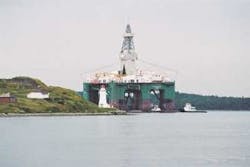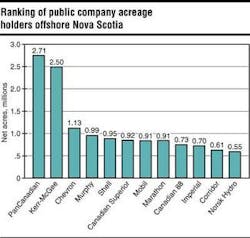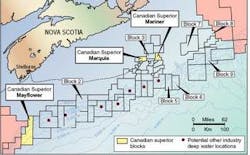Deepwater activity on rise offshore Nova Scotia
Fifteen deepwater wells are already scheduled to be drilled over the next three years offshore Nova Scotia. The first of these is already underway. Mara-thon Oil is drilling the Annapolis well in Exploration License 2377 in 5,741 ft water depth, the deepest in the area. Marathon plans to drill the well to about 19,400 ft, but progress has been made difficult by elements beyond Marathon’s control. Smedvig’s West Navion drillship, designed to work in ultra-deepwater and harsh environments, is on site, but it was plagued with problems. Initially cracks in the worn sheaves in the hoisting system of the dual derrick needed repairing. Then, defects in both utilized and unutilized risers appeared, causing several more weeks of idle rig time.
PanCanadian, which also has an interest in the Annapolis well, is making plans for its own prospects in the region. The company has formed a partnership with Ocean Rig ASA for the semisubmersible Eirik Raude, which is being completed at a shipyard in Halifax Harbor. The rig is to be ready by mid-year and should begin drilling by early fall, according to Larry LeBlanc, Vice President of East Coast Operations for PanCanadian, though the decision had not yet been made as to precisely where the semi would drill first. There are a number of possibilities. "PanCanadian has 17 blocks offshore Nova Scotia and is actively looking at those blocks from an exploration perspective," LeBlanc said.
Meanwhile, Chevron Canada Resources Ltd. plans to spend $47.8 million drilling a single deepwater exploration well off Nova Scotia in the next couple of months. The well, on the Newburn prospect on the Mahone Block southwest of Sable Island about 60 miles from the Annapolis well, was scheduled to spud by early April. A 3D seismic survey acquired in 2000 by Shell was analyzed to target this location, according to Drew Taylor, Drilling Project Coordinator for Chevron Canada Resources. "We’ve very excited about this opportunity," Taylor said, explaining that the well will target deep gas. Transocean Sedco Forex’s deepwater drillship Deepwater Millennium was contracted to drill the well, which is planned for completion 100 days after drilling begins.
Shell is also in the front line of offshore development. Drilling is underway in the shallower depths near Deep Panuke, but the company is looking into deepwater exploration as well. Present efforts are directed at interpreting 4,500 sq km of 3D seismic shot in the region and determining the best place to drill. "A large number of operators will begin drilling at the same time at the beginning or middle of 2003," said Doug Gregory, Manager of Shell Canada’s East Coast operations.
One of those companies is Kerr-McGee, which is currently laying plans for a deepwater drilling project scheduled to get underway this year. According to the Nova Scotia Petroleum Directorate, Imperial Oil Ltd. also has significant commitments remaining in deepwater.
Seismic shows promise
Some companies that have contracted seismic studies and evaluated the resulting data are convinced that this region is very prolific and that the drill bit will prove their optimism. "The main element in the dynamics of North American gas is this basin," said Greg Noval, President of Canadian Superior Energy Inc., which holds .92 million net acres in the area.
Canadian Superior’s acreage includes the recently acquired Mayflower Block 3,300 to 4,950 ft water depths, the southwesternmost block owned by the company and the closest Canadian block to New England. Newly shot, high-resolution, proprietary seismic data on Canadian Superior’s Marquis prospect, which lies north and east of the Mayflower Block in shallower water, has identified three large deepwater turbidite structures similar to some of the most prospective oil-bearing areas in the world, Noval said. The company hoped to spud a well by April or May 2002, he said. According to Noval, potential reserves could be as high as 2.4 tcf, which indicates potential production levels of 400 MMcf/d to 500 MMcf/d. Some of the finds to date have been substantial, and estimates published by the Canada-Nova Scotia Offshore Petroleum Board place undiscovered reserves for the Scotian Shelf at 13 tcf.
Don Axford, Chairman of the Board at Canadian Superior, is credited with identifying and proving the reserves of the Sable Island area. His instinct and expertise have guided the company to increase its acreage in potential exploration areas on the Scotian Shelf. Recent seismic surveys carried out by GSI helped to confirm Axford’s hunches. And now, the company holds some of the most prospective blocks in the region, Noval said. Canadian Superior’s Marquis Block, geologically upslope to Deep Panuke, could be on a par with Deep Panuke in terms of reserves. And the company’s Mariner Block also looks like a winner, according to Noval. "We think we’re sitting on the two most immediate plays for new gas," he said. This optimism will be put to the test when exploration drilling gets underway in the next month or so.
Plans for exploration activity are heating up across the board. "PanCanadian is actively looking at its blocks from an exploration perspective and is planning to shoot additional seismic this year to try to develop more drilling locations. 2002 and 2003 will be active drilling years offshore Atlantic Canada," said PanCanadian’s LeBlanc.
Obstacles
Though the waters offshore Nova Scotia are not threatened by icebergs like Newfoundland to the province’s northeast, the climate and sea conditions constitute a harsh environment and require rigs that cannot only operate in rough wind and waves, but in temperatures that are colder than those associated with North Sea operations. The strong storms and high seas in the area are unique in that the high winds and waves do not always come from the same direction. Sometimes, the winds come up from the Gulf of Mexico northward along the Atlantic seaboard, and sometimes, northeast winds blow in from Newfoundland.
Deepwater brings additional concerns. One serious consideration is the strong subsurface currents that occur because of the steep inclination of the continental shelf. If rigs are going to work year-round, they have to be able to contend with this harsh environment, and they must also be winterized for temperatures that fall below those normally experienced in the North Sea. When drilling gets underway in full force, there will be a lot more demand for harsh-environment drilling rigs in Atlantic Canada. Certainly, riser design and analysis become critical issues as well when subsea conditions are so dynamic. And production issues will have to be addressed when the time comes to begin developing fields in the region.
Building on success
Environmental and technical concerns, significant as they are, are not putting a damper on interest in the area. A lot of money has been earmarked for exploration and production offshore Nova Scotia for the coming year. In fact, this year, PanCanadian approved the second biggest budget in company history, $1.71 billion, which will fund production growth from Canada’s Western basin and reserve growth in offshore and international projects. PanCanadian will spend over $270 million on exploration and development, $72 million of which will go to the Deep Panuke Field, the company’s major prospect on the Scotian Shelf off Nova Scotia. The total anticipated investment by PanCanadian in the Deep Panuke development is approximately $630 million.
Deep Panuke is a world-class development, adding to PanCanadian’s strength in Atlantic Canada. In February of last year, the company announced plans to produce natural gas from the Deep Panuke reservoir, about 250 km southeast of Halifax. Commercial production is expected to begin in 2005.
Gas will be moved from Deep Panuke onshore through parallel subsea pipelines that will connect to the Maritimes & Northeast Pipeline. The Deep Panuke project is in the early stages of development, with a front-end engineering design study currently in progress. Results from that study are expected early this year.
Huge as Deep Panuke is, the general feeling of investors in the region is that a lot more waits to be discovered.
With that in mind, in mid-December 2001, El Paso Corp. began engineering studies for a proposed $1.6 billion pipeline that would carry gas from Nova Scotia fields to markets in the US and Canada. The Blue Atlantic pipeline will be 750 miles long and designed to accommodate 1 bcf/d, which takes into account a predicted increase in gas demand in the northeastern US that could require additional capacity on the line than is presently needed. Preliminary studies on the line should conclude by the end of the year.
Canada’s East Coast is no longer on the periphery; it is one of the focal points for hydrocarbon exploration and development. And with the resolution of the Newfoundland/Nova Scotia boundary dispute, even more acreage will open up for exploration and development. In short, the future is bright for this province. "This is going to be an exciting period of time, and we’re definitely in the exploration phase. I think the next couple of years will be exciting times for this region," LeBlanc said.



